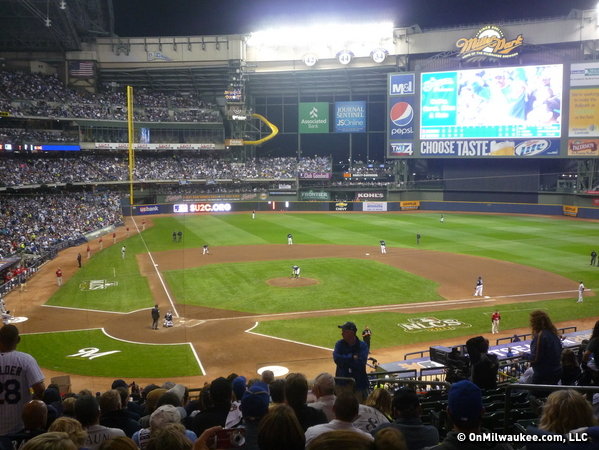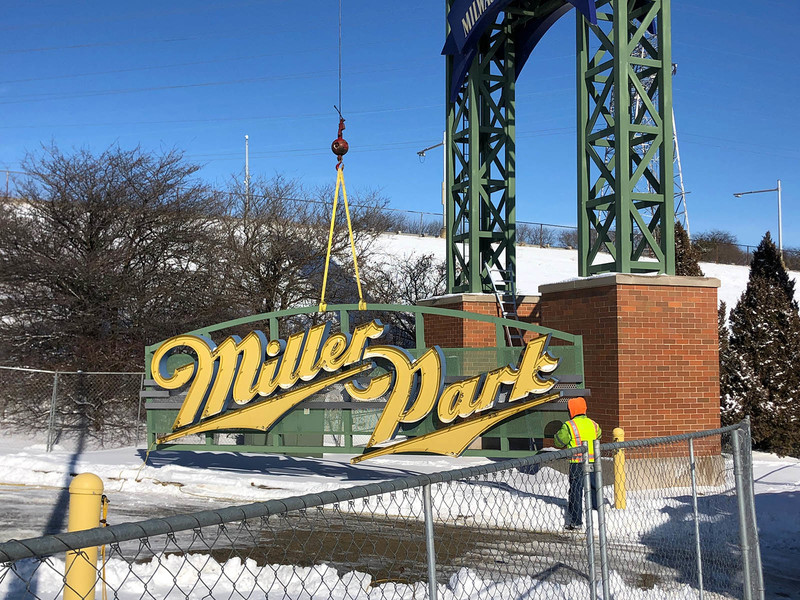Miller Park, home of the Milwaukee Brewers since the 2001, has received one of the most prestigious honors for facility sustainability and conservation efforts.
The U.S. Green Building Council (USGBC) has announced that Miller Park is LEED (Leadership in Energy and Environmental Design) certified in the category of Existing Building Operations & Maintenance, making it the first stadium with a retractable roof and just the third Major League Baseball stadium overall to receive the designation.
The honor recognizes the Brewers and its partners, led by facility manager Johnson Controls, Inc. (JCI), for their commitment to sustainability and efficiencies in the operations of Miller Park.
Miller Park is one of the most complicated buildings ever certified in the LEED Existing Building rating system, due to the nature of the facility, the sheer volume of people, materials, vendors, the operable roof, and overall complexity of the building operations.
Only two other Major League Baseball stadiums have achieved LEED for Existing Buildings (AT&T Park in San Francisco and Target Field in Minneapolis), and both of them are open-air facilities.
The retractable roof makes meeting energy and ventilation thresholds more challenging.
"We are thrilled with the news of the LEED certification and want to thank all of our partners who were involved in the process," said Milwaukee Brewers Executive Vice President – Finance and Administration Bob Quinn.
"It is a challenge to achieve the designation in an existing building of this size and type, but we have all been focused on the end goal. Earning this designation means that we have significantly improved our sustainability and energy efficiency, and the benefits extend to the organization, our fans, partners, and the environment."
LEED certification provides independent, third-party verification to confirm that a building is operated using strategies aimed at achieving high performance in key areas of human and environmental health: sustainable site development, water savings, energy efficiency, materials selection and indoor environmental quality.
LEED-certified buildings are designed to lower operating costs and increase asset value, reduce waste sent to landfills, conserve energy and water, be healthier and safer for occupants and reduce harmful greenhouse gas emissions.
Johnson Controls, Inc. managed the LEED process at Miller Park, helping the Brewers identify projects in many different categories to help them become more sustainable, as well as help draft policies to adhere to sustainability goals moving forward.
The LEED certification process involved coordination with many additional stakeholders at Miller Park.
In addition to the Brewers and JCI, key partners included Performance Clean LLC, Sportservice, Grumman/Butkus Associates, Waste Management and The Southeast Wisconsin Professional Baseball Park District. Others involved included ImPark, Hunzinger Construction, Mortenson Contruction and Uihlein Wilson Architects.
"LEED certification at Miller Park required a tremendous team effort. Johnson Controls is proud to have facilitated the process to achieve the rigorous goals set by the US Green Building Council's LEED rating system," said Kim Hosken, director of green building services, Building Efficiency, Johnson Controls.
"The Brewers organization deserves the recognition for their commitment to make Miller Park among the most sustainable stadiums in professional sports."
Numerous initiatives and studies were implemented throughout the process, ensuring that Miller Park will remain a leader in LEED qualifications.
Examples include the following:
- The Milwaukee Brewers and the Southeast Wisconsin Professional Baseball Park District implemented a Retro-commissioning project, which analyzed and made improvements to Heating, Ventilation & Air Conditioning (HVAC) systems, equipment and controls, plumbing systems and electrical lighting and power systems. This resulted in reducing 1,153 metric tons of CO2 emissions annually, the equivalent to taking 220 cars off the road each year.
- A retrofit to water fixtures in Miller Park was completed, which will save three million gallons of water annually.
- More than 40 large recycling containers were added in the parking lot areas, as well as 100 additional containers inside Miller Park.
- All waste and recycling is now tracked, and 35 percent of all waste has been diverted from landfills to recycling since the start of the 2010 season.
- On average, Miller Park recycles approximately 10 tons of waste from each game.
- The new Hi-Def scoreboard uses 49 percent less energy than its predecessor.
- Over 50 percent of all cleaning products meet sustainability criteria as "Green Cleaning" products.
- All smoking areas are at least 25 feet from operable doors, windows, and intakes, which preserves the indoor air quality for occupants.
- The Brewers and Sportservice donated over 7,000 pounds of food to area food banks and shelters in the last half of the 2011 season through the "Rock It and Wrap It Up" program (providing meals for 5,300 people to date).
- A Brewers "Green Week" eCycling event gathered over 40,000 pounds of electronics waste to be recycled.
- On June 22, 2011, the Brewers hosted a "Plant a Tree" program in conjunction with WDNR. Over 7,000 spruce seedlings were distributed to fans as part of the program. In addition, the Brewers committed to planting one tree for every 20,000 tickets sold in 2011 (154 trees). All trees are being planted along the Hank Aaron State trail and will be native Wisconsin species. The program will continue in 2012.
"While we are honored to have achieved this designation, our commitment will continue in 2012 and beyond," said Brewers Chief Operating Officer Rick Schlesinger. "We are committed to improving our efficiencies and programs and will look to keep Miller Park as an industry leader in these efforts."







